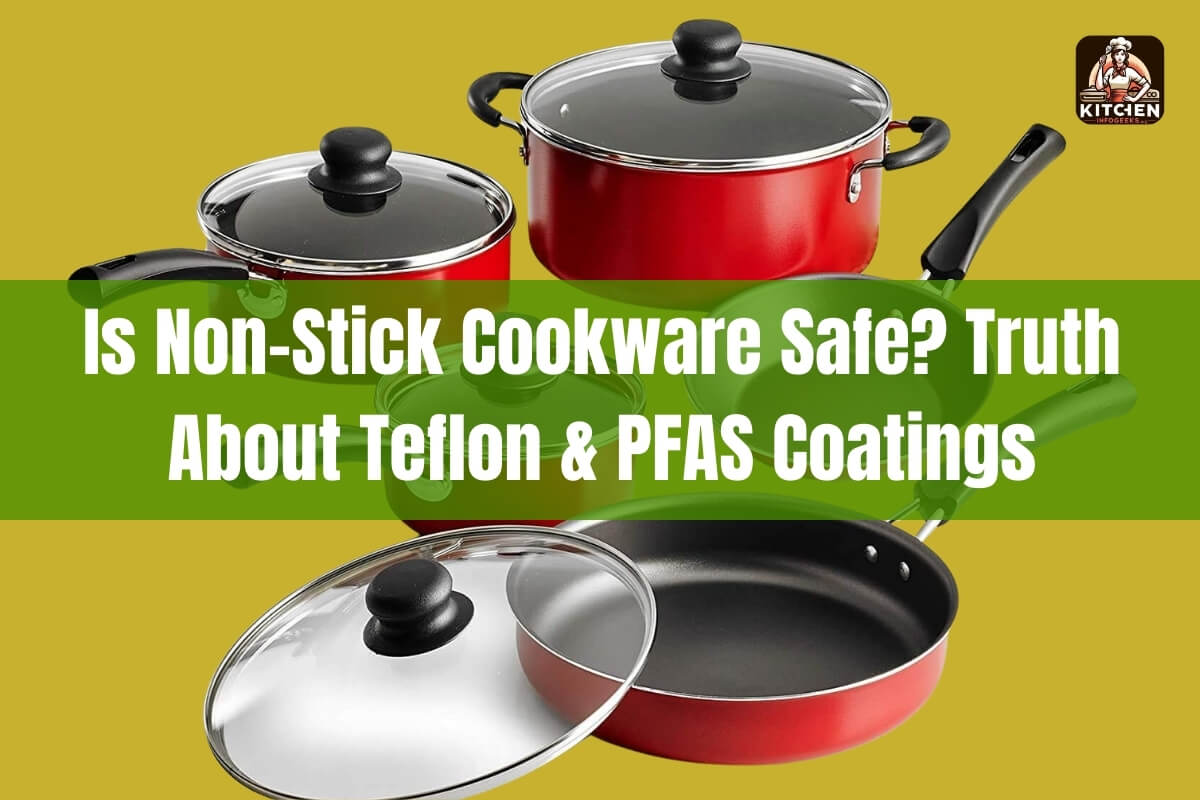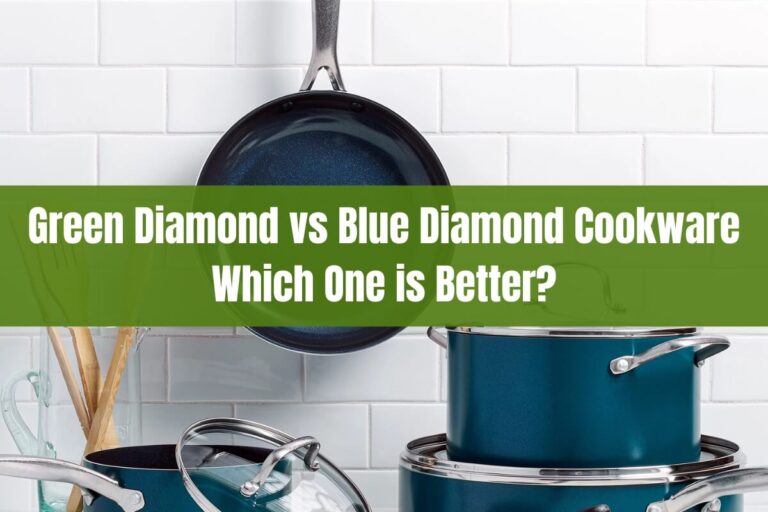
Are you worried about using non-stick cookware? With all the controversies surrounding Teflon and PFAS chemicals, it’s natural to have concerns. The short answer is: modern non-stick cookware is generally considered safe when used correctly, but there are some precautions to keep in mind.
In this comprehensive guide, we’ll dive deep into the topic of non-stick cookware safety. We’ll explore the materials used in non-stick coatings, the potential health risks associated with them, and the latest regulations and guidelines. We’ll also discuss safer alternatives and provide tips for using non-stick cookware safely.
What is Non-Stick Cookware?
Non-stick cookware refers to pots, pans, and other cooking utensils coated with a slippery material that prevents food from sticking. The most common coating used is polytetrafluoroethylene (PTFE), better known as Teflon.
Teflon and similar coatings make cooking and cleaning easier. Food slides right off, and you can use less oil or butter. That’s why non-stick cookware is extremely popular in households worldwide.
The Controversy Surrounding Non-Stick Cookware
Despite its convenience, non-stick cookware has been the subject of controversy and concerns over potential health risks. The main issue revolves around a chemical called perfluorooctanoic acid (PFOA), which was previously used in the manufacturing process of Teflon.
PFOA belongs to a group of synthetic chemicals known as per- and polyfluoroalkyl substances (PFAS). Studies have linked PFOA exposure to various health problems, including certain cancers, thyroid disorders, and reproductive issues.
Understanding PFAS and Their Potential Risks
PFAS are a large family of chemicals known for their resistance to heat, water, and oil. They are widely used in various products, including non-stick cookware, food packaging, carpets, and clothing.
However, PFAS are extremely persistent in the environment and can accumulate in the human body over time. Exposure to high levels of PFAS has been associated with several health concerns, such as:
- Increased risk of certain cancers (kidney, testicular)
- Thyroid disorders
- Reproductive and developmental issues
- Liver and kidney problems
- High cholesterol levels
It’s important to note that not all PFAS chemicals have been studied extensively, and their specific health effects may vary. Additionally, most exposure to PFAS likely comes from sources other than non-stick cookware, such as contaminated drinking water and food packaging.
The Safety of Modern Non-Stick Cookware
In response to concerns about PFOA, manufacturers have phased out its use in non-stick cookware production. Since 2013, all Teflon products have been PFOA-free.
However, some other PFAS chemicals may still be used in non-stick coatings. The potential risks associated with these newer PFAS compounds are still being studied.
According to the U.S. Food and Drug Administration (FDA), there is currently no evidence that the authorized PFAS substances used in cookware pose a safety concern for consumers when used as intended.
Manufacturers also claim that the PFAS molecules in non-stick coatings are tightly bound to the surface and do not migrate into food during normal cooking temperatures.
Alternatives to Non-Stick Cookware
If you’re still concerned about the potential risks of non-stick cookware, there are several alternatives to consider:
Stainless Steel Cookware: Stainless steel is durable, scratch-resistant, and can withstand high temperatures. It’s an excellent choice for sautéing, browning, and searing.
Cast Iron Cookware: Properly seasoned cast iron pans can develop a natural non-stick surface. They are long-lasting and can handle high heat. However, they require special care and maintenance.
Ceramic Cookware: Ceramic non-stick cookware is marketed as a “green” alternative to traditional non-stick coatings. However, it may be less durable and scratch-resistant.
Carbon Steel Cookware: Similar to cast iron, carbon steel pans can develop a non-stick surface when seasoned correctly. They are lightweight and responsive to temperature changes.
Stoneware: Stoneware has been used for centuries and can provide a naturally non-stick surface when seasoned. It’s scratch-resistant and can withstand high temperatures.
Tips for Using Non-Stick Cookware Safely
If you choose to continue using non-stick cookware, follow these tips to minimize potential risks:
- Avoid high temperatures (above 500°F/260°C), as non-stick coatings can start to break down and release fumes.
- Use wooden, silicone, or plastic utensils to prevent scratches that can cause flaking.
- Hand-wash non-stick cookware gently with a soft sponge and mild soap.
- Replace non-stick pans when the coating starts to peel, flake, or become visibly worn.
- Ventilate your kitchen or use an exhaust fan during cooking.
Frequently Asked Questions
Is it safe to use metal utensils on non-stick pans?
No, it’s best to avoid using metal utensils on non-stick cookware as they can scratch and damage the coating, potentially causing it to flake off and contaminate your food.
Can non-stick coatings flake off and enter food?
While manufacturers claim that non-stick coatings are tightly bound to the surface, it’s possible for small amounts to flake off, especially as the cookware ages and becomes scratched or worn. It’s generally recommended to replace non-stick pans when the coating starts to deteriorate.
Are there any health risks associated with ingesting non-stick coatings?
There is limited research on the potential health effects of ingesting small amounts of non-stick coatings. While some studies suggest it may be relatively harmless, it’s best to avoid ingesting any flakes or particles from non-stick coatings as a precautionary measure.
How do I know when it’s time to replace my non-stick cookware?
It’s time to replace your non-stick cookware when the coating starts to peel, flake, or become visibly scratched or worn. This can increase the risk of particles entering your food and also make the cookware less effective at preventing sticking.
Conclusion
In conclusion, modern non-stick cookware is generally considered safe for use when following proper handling and usage guidelines. However, it’s important to be aware of the potential risks associated with PFAS chemicals and to take precautions to minimize exposure.
If you’re concerned about the safety of non-stick cookware, consider switching to alternatives like stainless steel, cast iron, or ceramic cookware. Regardless of the type of cookware you use, it’s always a good idea to follow safe cooking practices, such as avoiding high temperatures, using the appropriate utensils, and properly maintaining and replacing cookware when necessary.
By being informed and taking reasonable precautions, you can enjoy the convenience of non-stick cookware while minimizing potential health risks.






